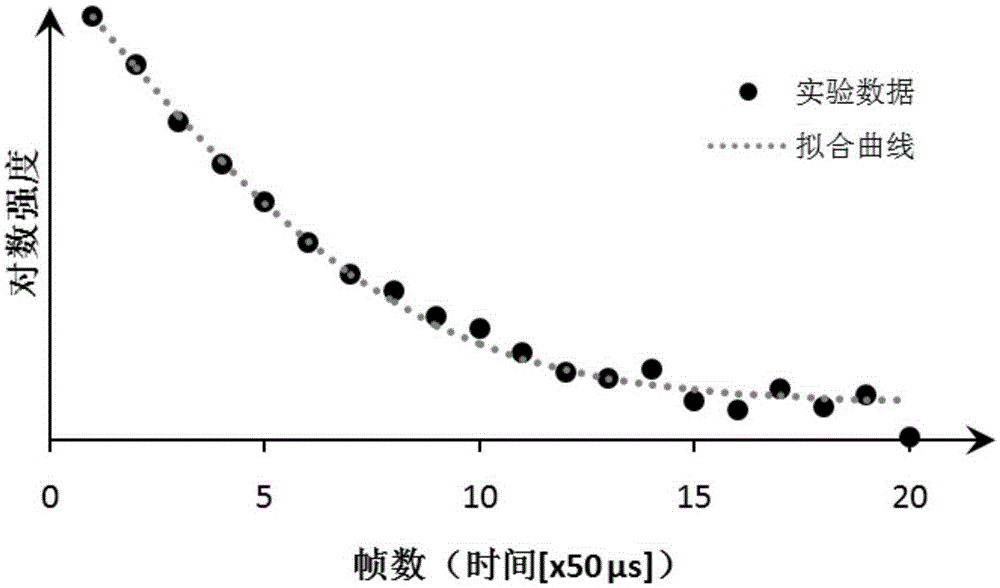Method and device for testing fluorescence life time
A fluorescence lifetime and measurement method technology, applied in fluorescence/phosphorescence, material excitation analysis, etc., can solve the problems of time-consuming adjustment and processing, complex optical path, expensive price, etc., achieve fast and high-throughput real-time online measurement, and simple device , low cost effect
- Summary
- Abstract
- Description
- Claims
- Application Information
AI Technical Summary
Problems solved by technology
Method used
Image
Examples
Embodiment 1
[0029] Fix the substrate with No. 1 fluorescent substance to be tested on the sample holder, and irradiate the sample with a pulse light source with a pulse repetition frequency of 1 kHz. The high-speed camera continuously shoots the fluorescent signal, and the exposure time of each frame is 50us. In the series of photos taken, a fluorescent signal corresponding to the repetition frequency of the excitation pulse appears, and the fluorescent signal changes periodically from strong to weak. A total of 20 photos in which the fluorescent signal continuously changes from strong to weak were randomly selected. Capture the corresponding position of the fluorescent substance in the photo, such as figure 1 shown. Then plot the sum of the gray values of all pixels in each frame against time to obtain the fluorescence decay curve, as shown in figure 2 shown.
[0030] Then use the single exponential decay function I(t)=I bg +A·exp(-t / τ) fits the data points, where, I bg is the b...
Embodiment 2
[0032] Fix the substrate with No. 2 fluorescent substance to be tested on the sample holder, and irradiate the sample with a pulse light source with a pulse repetition frequency of 1 kHz. The high-speed camera continuously shoots the fluorescent signal, and the exposure time of each frame is 50us. In the series of photos taken, a fluorescent signal corresponding to the repetition frequency of the excitation pulse appears, and the fluorescent signal changes periodically from strong to weak. A total of 20 photos in which the fluorescent signal continuously changes from strong to weak were randomly selected. Capture the corresponding position of the fluorescent substance in the photo, such as image 3 shown. Then plot the sum of the gray values of all pixels in each frame against time to obtain the fluorescence decay curve, as shown in Figure 4 shown.
[0033] First use the single exponential decay function I(t)=I bg +A·exp(-t / τ) fits the data points, where, I bg is the ...
Embodiment 3
[0035] Fix the substrate with No. 3 fluorescent substance to be tested on the sample holder, irradiate the sample with a pulse light source, and operate according to the method of Example 1 (the exposure time of each frame is 100 μs, continuous shooting pulse light source excitation, repetition frequency is 500μs), get as Figure 5 Fluorescence decay images are shown. Due to the high pulse repetition frequency of the excitation light source, the fluorescence signal of the substance to be measured has not decayed to a lower value, and the next excitation pulse has arrived.
[0036] In this case, multi-segment fluorescence decay time series can be used for fitting, and the fitting result is as follows Figure 6 As shown, using the calculation formula in Example 2, the average value of the obtained fluorescence lifetime is 200 μs.
PUM
 Login to View More
Login to View More Abstract
Description
Claims
Application Information
 Login to View More
Login to View More - R&D
- Intellectual Property
- Life Sciences
- Materials
- Tech Scout
- Unparalleled Data Quality
- Higher Quality Content
- 60% Fewer Hallucinations
Browse by: Latest US Patents, China's latest patents, Technical Efficacy Thesaurus, Application Domain, Technology Topic, Popular Technical Reports.
© 2025 PatSnap. All rights reserved.Legal|Privacy policy|Modern Slavery Act Transparency Statement|Sitemap|About US| Contact US: help@patsnap.com



